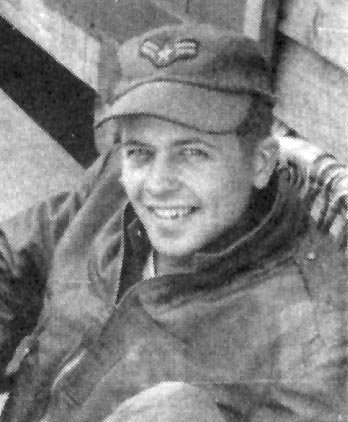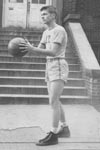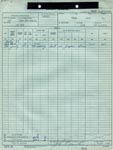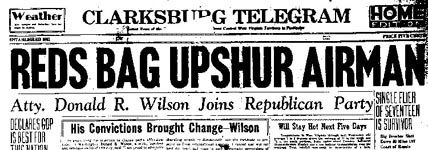

Remember...
James Edwin Woods
1931-1953
"It is good that war is so terrible, else we should become accustomed to it."
Robert E. Lee |
Remember...James Edwin Woods
|
| James Edwin Woods, son of Walter R. and Elizabeth [Cogar] Woods, was born on December 10, 1931, in Parkersburg, West Virginia. In 1949, James graduated from Buckhannon-Upshur High School in Buckhannon, West Virginia. He was very popular and well liked, and played forward on the basketball team. In the fall of 1949, James enrolled at Potomac State College at Keyser, West Virginia, where he lettered in basketball, but he dropped out of college to enlist in the Air Force in February 1951. |  |
After receiving his basic training at Sampson Air Base, New York, James transferred to Lowry Air Force Base in Denver, Colorado, where he trained as a gunner on the B-29. In October 1951, James was sent to Randolph Field in Texas for training in combat flying. Early in 1952 he was transferred to Hunter Air Force Base in Savannah, Georgia, where he became part of a Strategic Air Command group as a right gunner on the B-50. James was sent to Ramey Air Base in Puerto Rico for eight months and then to Forbes Air Force Base in Topeka, Kansas, for training to prepare him for duty in the Far East.
In March 1953, James arrived at Yokota Air Base, Japan. Now an Airman 2nd Class, he was a crew member of a US RB-50G with the 343rd Strategic Reconnaissance Squadron of the 55th Strategic Reconnaissance Wing, which was attached to the 91st Strategic Reconnaissance Squadron.
| After completing the mission at about 6:15 AM, the US RB-50G was returning to the base at Yokota when it was intercepted and unexpectedly fired upon from the rear by two Russian MiG-17 fighter planes. The gunfire from the MiG-17 at the rear disabled the RB-50G's No. 1 engine and set the No. 4 engine on fire. The attack also tore off part of the tail section and destroyed the wing. As the tail gunner, James Woods was able to return a brief burst of fire at the MiG-17, but to no avail, and commander Captain Stanley O'Kelley ordered the crew to bail out. The plane lost altitude quickly and crashed into the sea. The attack occurred two days after the armistice ending the Korean War was signed on July 27, 1953. | 
|
 |
The US conducted a thorough search of the area by air and sea, and was assisted by an Australian ship near the crash site. Halted due to dense fog and approaching darkness, the search was resumed on the morning of July 30, 1953. Captain John Roche, co-pilot of the plane, was wounded but survived the crash by holding onto pieces of the wreckage. He was picked up by the Navy ship USS Picking in the early morning hours of July 30, 1953 after floating in the Sea of Japan for about 22 hours. No other survivors were found. The bodies of Captain Stanley O'Kelley and Master Sergeant Francis Brown were later recovered along the coast of Japan. The remaining 14 members of the crew, which included James Woods, were never accounted for. |
 |
The Soviet government maintained that about 6:00 AM on the morning of July 29, 1953, a US Air Force RB-50G aircraft violated the boundary of the USSR in the region of Cape Gamov and flew through their airspace to the area of Ajton Island near Vladivostok. The Soviets claimed that two Russian MiG-17 fighter aircraft approached the US RB-50G with the intention of showing the crew that they were within the boundaries of the USSR and urging them to leave Soviet airspace. The Soviets stated that the US RB-50G aircraft was last seen flying out to sea and they had no further knowledge of the fate of the plane or its crew. However, according to Captain Roche, several Russian boats were in the area immediately after the crash, and crew members of the rescue planes searching the site also reported sightings of Russian boats and planes in the area that may have picked up other possible survivors or remains. |
Throughout the 1950s and early 1960s the US government made repeated requests to the Soviet Foreign Ministry for information regarding the July 29, 1953, attack on the US Air Force RB-50G plane but received little or no response. In June 1992 Russian President Boris Yeltsin admitted that the Soviets had shot down nine US planes during the 1950s and held twelve of the survivors prisoner. It is not known whether any of these prisoners were crew members aboard the US RB-50G which was shot down on July 29, 1953.
In a letter to President Eisenhower, Elizabeth Woods spoke of her feelings about the fate of her son and other Cold War MIAs: "I write from the fullness of my heart and not with bitterness or resentment. I love my son as you do yours. I only pray that if he is dead that God will ease the pain and loss. But if he with his crew members are in a slave camp somewhere, God forbid our neglect of them."
At the time his plane was shot down, James Woods was engaged to Helen Snow of Denver, Colorado, and they planned to be married in September 1953 after his tour of duty in the Far East was completed. A few years later, she married someone else, and later had a son whom she named after James.
James' father Walter Woods died in 1988, and his mother Betty passed away in 1996. James is survived by his sisters Colleen [Woods] Einhorn and Kathryn [Woods] Chettle.

West Virginia Archives and History welcomes any additional information that can be provided about these veterans, including photographs, family names, letters and other relevant personal history.